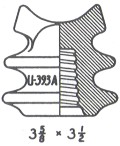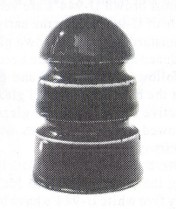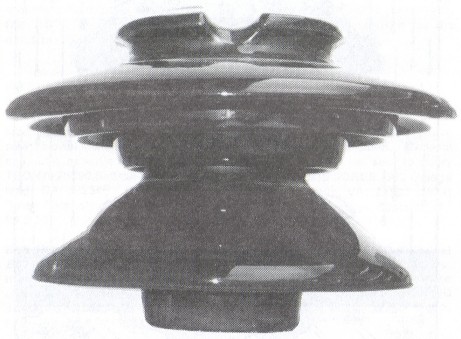Porcelain Insulator News
by Elton Gish
Reprinted from "Crown Jewels of the Wire", November 1998, page 26
In the last PIN (September CJ) we incorrectly reported that the Pittsburg
U-393A's were used on an old trolley line in Chattanooga, TN. Thanks to Ken
Roberts (NIA #5962) for correcting the report. Ken said Charles Kocisek found
the U-393A's in an abandoned substation house on the T.V.A. Reservation in
Muscle Shoals, AL. The U-393A style is rare and glad we are able to report the
correct information. All previous examples of this style are damaged specimens
found in the Pittsburg dump over 20 years ago.

Gary Scott (NIA #5758) reported a
very rare and exciting find. Late last year Gary reported finding a very near
mint U-945 "Mershon Type" in a barn in Watertown, New York!! Only six
U-945's are known counting the one Gary found. The insulator has since found a
new home with Jeff Kaminski (NIA #3582). I hope it is not too uncomfortable
among Jeff's collection of large multipart porcelain insulators, many of which
are 50+ pound 4-part multis.
For those of you not familiar with U-945, it is a 3-part glazeweld made by
the R. Thomas & Sons Co. in East Liverpool, OH circa 1898-1903. Thomas
patented the glazewelding process on March 8, 1898, which they called
"glaze-filling". The incuse marking found only on U-945, "MERSHON
TYPE / PATENT / JUNE 7, 98", refers to the Ralph D. Mershon patent No.
605,256 granted on June 7,1898, for the extended petticoat. Glass insulators
made according to the Mershon patent also have raised ridges across the top
surface of the outer skirt, which aid in directing rainwater away from the
crossarm. U-945 only used the novel extended petticoat, which protected the pin
from damp weather to reduce electrical leakage from the surface of the insulator
to the pin. Thomas apparently produced U-944 based on this patent, too. Thomas
was granted patent No. 601,195 on March 22, 1898, for an almost identical idea
for the extended petticoat; however, the Thomas patent called for the extended
petticoat to extend through the crossarm which was impractical. The extended
petticoat through the crossarm would surely break with modest strain from the
conductor. The Mershon patent application was filed five years before the Thomas
patent. Evidently Thomas could not come up with a workable patent for the
extended petticoat so they decided to license the Mershon patent.
It is odd
that no U-944' s are marked or bear the Mershon patent date. We should point
out that the white U-944's appear older (manufacture of white insulators ceased
in 1901 reappearing in limited numbers in 1910's) and are 1/4" shorter than the
brown glazed ones (difference in the length of the extended inner skirt). U-944
was shown in the 1904 Thomas catalog (but not in the 1907 catalog) being offered
in either white or "chocolate color". The "chocolate color"
is "brown"; however, most brown U-944's are very dark and somewhat
unattractive. A couple ofU-944's have the early Thomas glaze that is mottled
orange and mustard. The first brown glaze Thomas used was caramel-colored
produced after white glaze became much less desired in 1901. This was followed
by mustard and orange/mustard glaze. Our best guess is that the beautiful
caramel glaze was produced circa 1901-1903, the attractive orange/mustard glaze
was produced circa 1904-1907, and followed by darker glazes with lesser amounts
of mustard and orange circa 1907-1910.
Brown U-944's were found on an old DC
line that ran along the Fall River Road from the power station to Idaho Springs,
CO. My records show that only five white U-944's have been reported and only
nine brown ones. I do not know where the white U-944's were found. You might
assume that the U-944 replaced the more delicate U-945. U-945 was not shown in
either the 1904 or 1907 catalogs. However, it did appear prominently on the cover of a Thomas publication dated March 8,
1902, (see page 137 in my book, Fred M. Locke: A Biography) commemorating the
victory over Fred Locke for Thomas' March 8, 1898, patent for the
"glaze-filling" process and introducing their "glaze-filled"
styles, U-928, U-928A, and U-945.
The demand for Thomas "glaze-filled"
insulators dropped dramatically with the introduction of cemented multipart
insulators. This occurred just prior to Thomas moving much of their production
of high voltage insulators to the old Westinghouse factory in Lisbon, OH in
1905. The 1907 Thomas catalog showed only three glazewelded styles: U-939B,
U-967, and U-936. However, the illustration of U-967 does not match the dimensions
shown for that style which more closely match that of U-956. All of the
production of these glazeweld styles in the 1907 catalog would have the dark
brown glaze.
Keith Roloson (NIA #3201) reported a very unusual U-58 exchange. It
is unmarked and made of dry process porcelain. At least it is unmarked in the
conventional manner. This is the first pin-type porcelain insulator that I have
ever heard of being marked in the top of the pinhole! There is a perfectly
formed "5" embossed (raised) in the top of the pinhole!!! Keith
checked all of his exchanges, I checked all of mine, and a couple of other
people checked their collection. This is the only one like this we have seen.
Please check your exchanges and report to me any similarly marked. It is not
obvious which manufacturer made this insulator. An argument could be made for
Square D but we cannot be sure.

U-58 with embossed "5" in top of pinhole.
Dennis Stewart reported a new multipart style. It has been assigned M-2617D.
It has the incuse marking #1 (see page 128 of Jack Tod's book, Porcelain
Insulator Guide Book) consisting of the Franklin Porcelain Co. name and round
logo. The one in the photograph below has a beautiful mottled mahogany glaze.
Dennis also found a second one with incuse "FP" marking on both the
top and bottom shells.

M-2716D (9 - 7.5 - 3 x 6)
with Franklin Porcelain Co. marking.
| 